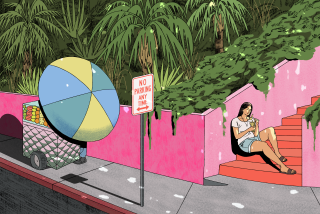NATIVE IN A STRANGE LAND : If You Grew Up in South-Central During the ‘50s and ‘60s, You Really Can’t Go Home Again
I get homesick. And that’s funny because I’ve never left Los Angeles long enough to miss it. Instead, it has left me.
I was born in a ramshackle A-frame in Watts proper. Those days, at the end of World War II, one whispered the name Watts. It was synonymous with violence, death, drugs, gang warfare and the worst “culturally deprived” colored/ Negro stereotypes. But most folks, like my parents, were decent, hard-working and law-abiding.
South-Central was predominantly white then, and we were the first black family on our block, part of a mushrooming Afro-American population spurred by white flight. The building of LAX, with increased noise and traffic, opened up “restricted” housing west of the Harbor Freeway. But we stayed put. The neighborhood declined.
At Broadway, the closings of the Manchester and AAA theaters, where I spent Saturday ‘noons, signaled the slide. When most of the remaining whites left, thriving businesses and financial institutions rapidly followed them out. By the mid-’60s, my home, South-Central, was predominantly black. A ghetto.
On my own, I lived in the Florence-Graham corridor. I liked the area’s clement weather, several degrees cooler than the Valley on the hottest days. The streets are wide and traffic jams rare.
I earned my pennies waitressing in the bars and nightclubs that seemed to sprout on any corner where there wasn’t a liquor store, gas station or church.
Few businesses were black-owned. Public service was no service. I didn’t have a chatter box in those days, and Ma Bell’s booths invariably stank of brew and urine, phones stripped. Laundromats were sites for street trade. Libraries were tombs.
The last remaining banks skimped on tellers, especially on “Mother’s Day,” when welfare checks and food stamps arrived. Lines often ran 30 to 40 deep.
Survival meant higher prices for inferior goods and services. Not to mention the police. Dope was craftily dealt over counters with bubble gum and beer. Food-to-go proliferated where restaurants feared to tread. “Fresh” food spoiled within hours of purchase at local markets.
Hell? Yes. Yet if I had my druthers, I’d live there today. But “there” no longer exists.
Since the Watts riot of August, 1965, blacks have been persistently forced out by a lack of jobs, by insurance and real estate redlining and the growth of a monster drug culture. This involuntary diaspora has been aided by the hundreds of businesses that failed to rebuild after that “long hot summer.” In pursuit of better jobs and decent housing, more than 75,000 blacks have left L.A.
Even I moved. To Hollywood. I got a job in the Valley, and the daily drive to and from 120th and San Pedro streets was killing my car. By the late ‘70s, my South-Central was “disappeared” as immigrants filled the gap created by “black flight.”
Once, in a New York restaurant, when conversation lagged, a stranger asked where I hailed from. “South-Central L.A.,” I answered.
He looked at me blankly. “I didn’t know there were any blacks in Los Angeles.”
“Watts,” I said, evoking images of the insurrection.
“Oh--yeahhh!” Suddenly I could be placed. I had my history. I had my spot.
I miss it. When the homesickness becomes chronic, I jump into my struggle buggy, set the boombox on max and go cruisin’ for the fix. Even the ghosts will do:
Usta climb them Watts Towers when I was a kid. Bought my first 45 single at that storefront usta be Dolphin’s of Hollywood. That was where Mama Washington fed all the wanna-bes, need-to-bes and izzes. Rudy Ray Moore usta hang on that there corner. That gravel over there is the remains of the motel where Sam Cooke was wasted. Usta get down at the Kick-A-Poo Joy Room. Johnny’s had the best French toast in town. That was the first clubhouse for The Chosen Few. The best storytellin’ come with a haircut at Oxidean’s. Yonder over there, they smoked the Symbionese Liberation Army.
Street after street, I follow the erratic map of my heart. Where my home is. As the saying goes.
More to Read
Sign up for Essential California
The most important California stories and recommendations in your inbox every morning.
You may occasionally receive promotional content from the Los Angeles Times.










